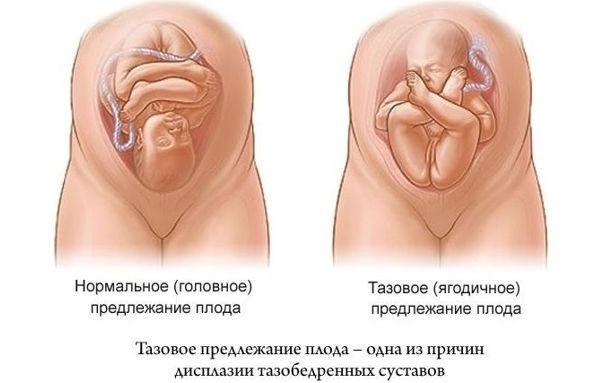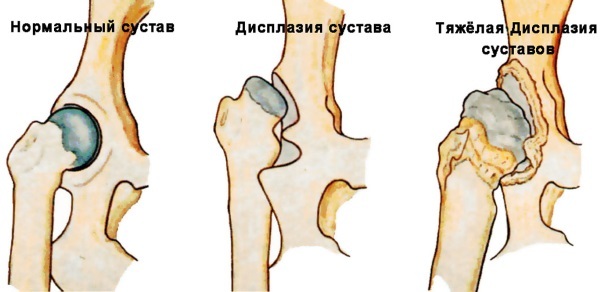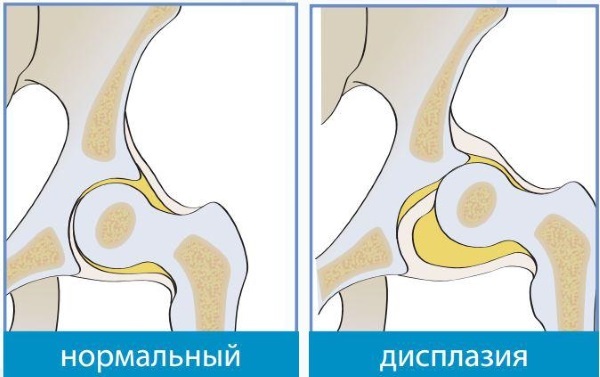A newborn is common pathology such as hip dysplasia. Diagnose the abnormality is difficult. The first symptoms appear in a child up to a year. Pathology is fraught with complications that affect the quality of life of the baby.
The content of the article:
- 1 What it is?
- 2 Causes of
- 3 Types and degrees
- 4 symptoms
- 5 Diagnostics
- 6 Treatment
- 7 wide swaddling
- 8 Pavlik stirrups
- 9 Frejka pillow
- 10 bus Vilna
- 11 Parting Tyubingera
- 12 Volkova bus
- 13 Pants Becker
- 14 Sling and ergoryukzak
- 15 Physiotherapy
- 16 Massage
- 17 Gymnastics
- 18 Surgical intervention
- 19 rehabilitation period
- 20 Effects
- 21 Videos about hip dysplasia in infants, symptoms and treatments of disease
What it is?
Hip dysplasia in the newborn triggered by factors of a different nature, that cause wrong tab of the skeletal system. It occurs defective development of the joints that make up the child's pelvis. The basis of the disease is a violation of articulation between the femoral head and acetabulum.
Congenital anomaly of nature is often diagnosed. Typically, the process is developed on the left side. Right-handed form, as well as bilateral, less fixed.
Causes of
Medicine highlights numerous precipitating factors. Most of them have a negative impact in the first two months of gestation pregnant. It was during this period there is a tab musculoskeletal baby unit.

Among the main reasons it should be noted:
- Genetic background. Usually in the family, which met this pathology, the probability of having a child with abnormal morphology of joints high.
- The impact of chemicals on the body of the pregnant woman.
- Bad ecology.
- Oxygen starvation of the fetus.
- Age of mother. Pregnant women older than 35 years are at risk.
- body weight of the child at birth more than 4 kg.
- Prematurity.
- Infection of pregnant women.
- Child malnutrition, leading to a lack of necessary for bone and cartilage of vitamins and minerals. This provokes a breach of the morphology of bone tissue.
- Incorrect swaddling in which the legs are pressed tightly.
Types and degrees
The classification of different forms of the disease is based on a dominant performance. In the presence of dysplasia experts highlighted anatomical lesions. Also taken into account the degree of abnormality.
Among the anatomical level of lesions should be noted:
- acetabular shapeWhich is characterized by impaired morphology of large fragments of the pelvic joints. When it violated building limbus.
- epiphyseal shapeWhich is characterized by impaired joint mobility. Normal angle indicator when measuring joints functionality distorted.
- Rotary Die. This pathology involves a violation of the morphology of the joints, which provokes gait disturbance.

Hip dysplasia in the newborn and different degrees of severity.
In medicine, there are three levels:
- Easy. It was called "predvyvih". Significant violations that lead to the child's disability at this point is not observed.
- Moderate. This form is significantly impairs the quality of life of the child and requires active treatment.
- Heavy. This dislocation, which provokes the resulting contraction. The pathology is characterized by impaired functionality and joint deformity.
symptoms
If the pediatrician suspected the presence of dysplasia, it gives direction to the podiatrist's office. Congenital can be diagnosed already in the hospital. Anomaly 1 and 2 almost unnoticeable degree. Symptomatology manifested in two months, when the child begins to grow bone and cartilage.
The following symptoms are noted:
- asymmetry of skin folds in the area of the knees and hips;
- a baby crying in a dilution of feet;
- difficulty in movement bent legs.
Grade 3 dysplasia has a bright symptomatology:
- click, manifested in the reduction and separation of the legs;
- limitation of abduction at the hip, which signals the degenerative processes of the musculoskeletal system and violation of the morphology of bone tissue;
- visually noticeable incorrect articulation joints.
Children up to a year suffer from the same symptoms.

Also, the disease may be characterized by additional features, among which we should mention:
- atrophic process in the muscles;
- intensity insufficient blood circulation in the femoral artery;
- problem with sucking.
If the anomaly is not identified after a year, the dysplasia significantly impairs the quality of life of the child and gives a lot of problems to parents. The first attempts to walk the child will be accompanied by excruciating pain.
By striking signs of pathology include:
- lameness;
- pain when walking;
- inflammation in the joints.
Diagnostics
Hip dysplasia is diagnosed in the newborn specialist in the field of orthopedics. Medical practice such a profile can determine the existence of provoking factors, as well as the first symptoms of pathology. Usually, anomaly detection occurs within 6 months after the birth of the child.
For accurate diagnosis resorting to various kinds of additional diagnostic methods. The safest and quite informative considered ultrasound. Its interpretation makes it possible to detect a transient form of pathology, as well as to identify specific anomalies joint morphology.
Ultrasound allows the timing of ossification of the hip department. Ultrasound examination reveals anatomical defects inherent in various forms of dysplasia. This diagnostic method is safe for the child and can be carried out in the first months of his life. The endowment is not the joints.

Conducting diagnosis by X-ray shown in complex forms of the disease. X-rays do not apply if the child is less than one year. The study gives a clear picture of the anatomy of the defect. This diagnosis resorted in the presence of severe cases in clinical practice, when necessary to avoid concomitant pathological processes.
Surgical methods of diagnosis in a child up to one year and not used. Arthroscopy involves the use of surgical instruments for the study of the articulation of the joints. Such examinations have consequences and can cause secondary infections in the body.
MRI is scheduled before surgery. Orthopedics resorted to this diagnostic method, in difficult cases that require exception pathologies with similar symptoms.
Treatment
dysplasia treatment is carried out under the strict supervision of a specialist in the field of orthopedics. The only way to eliminate the symptoms inherent pathology. Therapeutic methods are selected after a physical examination and diagnostic procedures. In some cases, prescribe conservative treatment.
But some forms of disease require surgery.
wide swaddling
Diapering is an effective method of therapy. With its help is given to a few feet spaced position. The broad swaddling resort in the treatment of even the babies.
Pavlik stirrups
Pavlik stirrups - a special device for the treatment of children from birth to 9 months. They are able to ensure the desired position of the hip joint. Proper mounting is carried out by means of belts and tires. After such fixing knees flexed position and become divorced.

Fixing provides a full development of the joints, makes it possible to strengthen the ligaments. Secure attachment does not allow the bone to shift the mix. Pavlik stirrups are highly efficient. If abnormality is detected during the first 6 weeks of life baby, the success of treatment by this method is 95%.
Frejka pillow
Basis Frejka pillow - elastic cushion attached between the knees. Roller ensures proper joint growth. Child legs bent slightly diluted accept the position of the hip joint head part of the acetabulum.
The use of Frejka pillow is shown in the presence of congenital anomalies, provoking a dislocation and subluxation. When dislocation existing to such a method does not resort correction. Pathology requires surgery.
Newborn use of Frejka pillow is expedient to 1 month. The duration of use is determined by a doctor who will diagnose the degree of hip dysplasia. Usually the pillow used up to 3 months. With slow growth of the joint device can be used up to 2 years.
bus Vilna
Bus Vilna used in orthopedics in young children. The basis of the device is a telescopic strut-based materials such as aluminum or stainless steel. Device equipped with a screw and leather cuffs. Vilna tire is worn around the clock.
In pediatric orthopedics, this device is recommended at the end of the main course of therapy. Manufactured tire on an individual basis, taking into account age and physical parameters of the child. The only way possible to achieve a high level of therapeutic effect.

Before resort to use the bus, it is recommended to consult a podiatrist who eliminate the contraindications for this method of treatment.
Parting Tyubingera
Bus Tyubingera - diverter for effective treatment of dysplasia in infants from birth to one year.
The standard components of the device include:
- Shoulders, made of soft material and equipped with special fasteners;
- stops in the hips;
- central spacer for adjusting;
- Special buckle red and white;
- thread for connection with the beads.
Bus allows breeding legs to the side, causing the hip to take the correct position.
Volkova bus
To use Volkova tires resort is extremely rare. The basis of the device is polyethylene.
The adaptation includes four main components:
- crib, which is placed under the back of the baby;
- an upper component, which is put on the abdomen;
- side components that secure the femur and tibia.
This device is used from birth to 3 years. The design is presented in four sizes.

The reasons for its rare use should include the following:
- the difficulty of selecting the right size structure;
- provision of certain rail fixing joints that can not be changed in case of need;
- sharp limitations baby movements;
- the high cost of the device.
Pants Becker
Becker pants are panties. They located a metal insert, covered with felt. For infants metal is replaced with a resilient material. Becker's pants are used for treatment of children from 1 to 9 months.
Sling and ergoryukzak
Sling or ergoryukzak can provide breeding feet. It is used to prevent and can not replace therapy. We do not recommend the use without permission from the specialist.
Physiotherapy
Based on the severity of the pathology, physiotherapeutic procedures are used as additional ways in conjunction with major forms of treatment. This approach is excellent barking results.

From physiotherapeutic techniques should be noted:
- UFO. It is carried out individually. It strengthens the immune system and provides rapid regeneration of bone tissue.
- electrophoresis using calcium and phosphorus. Substances strengthen joints and bones.
- appliqué with the content of ozokerite. It is applied to the joint to regenerate damaged tissue.
- warm bathContaining sea salt. Bath activates the immune system, stimulates blood flow and causes rapid restoration of damaged bone tissue.
Massage
In identifying the disease early enough to conduct several courses of massage to eliminate the existing problems. Manipulations are carried out by experienced professionals as any mistake fraught with major consequences for the organism.
Massage treatments in infants are carried out every day. For massage requires a firm surface. After a two-week course should take a break for 1-2 months.
Experts often resort to the following massage techniques:
- light stroking the back of the legs from the ankles to the hips;
- rubbing, massaging the legs suggesting the child;
- felting, in which there is obhvatyvanie hands hips and legs imitation felting.
Of the contraindications for massage it should be noted:
- elevated body temperature;
- underweight baby;
- inflammation of the skin;
- inflammation of the bone;
- heart disease;
- the presence of epilepsy;
- acute hepatitis;
- the presence of hernia;
- nerve disease;
- diathesis;
- Pathology of blood;
- pathological processes that have affected the liver and kidneys.
Gymnastics
The exercises can be performed both professionals and parents after their training. Movements should be smooth and soft.

Among the exercises which have the highest efficiency, it should be noted:
- Breeding feet. Grudnichok laid back. Are clasped knees, hips divorced in hand. The outer edge of the hips in contact with the surface on which the child is located. Duration manipulations is 1- 2 minutes.
- The rotational movement. With this manipulation of the child it is also in a supine position. One hand held the pelvis and the knee rotates inward.
- Okay. Feet are deployed together. They clap their palms like.
- Crawl. The child is placed on the abdomen, legs divorced aside and bent at the knees. Under the support of the foot is placed in the role of which can be a soft ball. From him grudnichok repelled legs and trying to crawl.
- Exercise with the ball. These exercises are taught gradually. Ball promotes relaxation of the muscular system.
- Water aerobics. Water relaxes the muscular system. A warm bath has a greater efficiency. The most effective reception in this case - a leg curl.
Surgical intervention
Hip dysplasia in the newborn in severe if you can not fix it by other methods require surgery. Children operated on at the age of 2-3 years.

Among the surgical techniques release:
- Open joint reduction. It is carried out in severe pathology with the presence of dislocation. When failure of the acetabulum is subjected to its depth specialists correction. Complication dislocation carried secondary surgery. After this operation the child for 2-5 weeks, the cast is applied.
- Corrective intertrochanteric osteotomy of the hip bone. Medical Practice describes 40 different ways to execute this operation. Osteotomy makes it possible to correct the impaired morphology of the hip joint.
- Acetabuloplasty. The basis of the surgical correction of the oblique angle of the top of the acetabulum pelvis of the ring without crossing. A similar effect is achieved by dissecting the surface of the ilium. After conducting the operation baby superimposed gypsum, which is removed after 2 months.
- The final results of surgery are measured by radiography. When acetabuloplasty often resorted to the use of implants for the correction of the acetabulum.
- Triple pelvic osteotomy. In medicine it is used several methods of operation. Surgery involves the intersection of all fragments pelvis ring (pubis, ischium and ilium). After that, the acetabulum is installed in the correct position, and the bones are fixed by the structure of titanium. Screws removed in 1.5 years. The operation is associated with trauma and can cause damage to the vascular system and nerves. It is distinguished by a long period of recovery. The narrowing of the pelvis can cause negative consequences in the future for girls.
rehabilitation period
Rehabilitation after surgery is a controversial topic for orthopaedists. Experts do not come to a consensus on how long should last plaster immobilization.
The main objectives of rehabilitation measures are:
- Optimization condition of the musculoskeletal system;
- Recovery of motor function;
- walking training.
Main recovery phase:
- period before surgery;
- wearing a plaster cast;
- change the cast on the bus Vilna.
The tire set one year after surgery and worn approximately 1.5 years. The overriding purpose of rehabilitation period is walking training. A child should not limp, maintain correct posture, to perform smooth moves.
Effects
Pathology need necessarily to eliminate, as it causes a lot of complications. Uncorrected position of the joints can lead to disability.

Among the main consequences should be highlighted:
- Loss of joint functionality, which occurs gradually. When the kid bent leg abduction experiences pain.
- Reduction of the injured extremity. Asymmetry becomes pronounced especially when the wrong swaddling.
- Changing the shape of the acetabulum.
- Violation of the symmetry of the pelvis.
Launched and cured pathology in infancy is fraught with the deterioration of the quality of life in adult years. Typically, adults with dysplasia characterized by extraordinary flexibility.
Over time, the patient may be:
- broken posture;
- appear stiffness and crackling sound in the joints;
- broken walking;
- be pinched nerves, causing numbness in the feet, legs and hips;
- develop early osteoarthritis.
When dysplasia person can not experience long-term exercise. The probability of breach of nerves and blood vessels. Among the aggravating effects stands neoarthrosis. When it comes to form a new joint. This adaptation of the organism with no dislocation of the cured. Such adaptive ability of the organism involves shortening and disruption of functionality thigh muscle system.
For the most severe complications of hip dysplasia in newborn specialists consider coxarthrosis. This disease involves the complete destruction of the hip joint. Usually this disease is diagnosed in humans 25 35. Coxarthrosis leads to disability and requires surgery. Otherwise, the person becomes incapacitated.
Videos about hip dysplasia in infants, symptoms and treatments of disease
Dr. Komarovsky of hip dysplasia:
Gymnastics at dysplasia:



